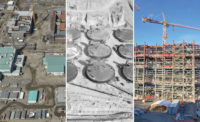The U.S. Energy Dept.’s most contaminated nuclear waste complex, the 580-sq-mile Hanford site in Washington state, would receive $3.1 billion to fund cleanup for fiscal 2025 in President Joe Biden’s proposed federal budget released on March 11. The amount tops a funding record already several days before in a revised total approved by Congress for the current fiscal year that ends Sept. 30.
The $205-million fiscal 2024 addition increased Hanford funding to just over $3 billion, its highest annual budget amount.
About two-thirds of the funding is designated for work to ready Hanford's massive site waste treatment plant to begin operating next year to vitrify for disposal millions of gallons of low-level nuclear and chemical wastes now stored underground. Funds also will support site waste storage and transport infrastructure.
Bechtel has managed the estimated $17-billion vitrification megaproject for more than 22 years.
The initial fiscal 2024 Hanford budget request was the second in a row by the Biden Administration with a reduced total, but the cuts were less than those proposed by the Trump administration.
The Washington Dept of Ecology, a regulator of Hanford cleanup work, says the new added funding is needed to keep the nation’s most complex remediation effort on track. From World War II through the Cold War, the site produced more than 67 tons of plutonium, generating millions of tons of radioactive and chemical wastes.
The state agency estimates Hanford needs $4.56 billion in fiscal 2025 to be in compliance with cleanup targets set under a federal-state agreement. “We will continue to advocate for sufficient funding in Washington, D.C., and get it to a level that keeps cleanup on track now and for years to come,” said Laura Watson, its director.
Washington Sen. Patty Murray (D) said the fiscal 2025 request "demonstrates a step in the right direction,” but she emphasized the federal government’s “moral and legal obligation" to properly fund work at Hanford. She is chair of the Senate Appropriations Committee.
Melter Makes Progress
Work to commission the second of two 300-ton waste melters at the waste treatment plant—the world’s largest and core to the vitrification process in heating waste to 2,100° F—achieved a first critical temperature of 300° F in testing March 13, DOE said. The agency called the test a “deliberative process” expected to take several weeks.
The first melter heatup process that began in October 2022 had to be halted but finally reached its temperature milestone in July 2023. “Achieving operational temperature and the concurrent running of both melters will represent a major step toward future immobilization of Hanford tank waste,” DOE said.
Brian Hartman, Bechtel senior vice president and waste treatment plant project director, said heating up the second melter is a significant accomplishment while operating melter one at the same time. At full temperature, crews will add glass beads to create a molten pool in which to mix glass.
DOE also said that Bechtel earned 92% of its potential fee for 2023 plant work related to engineering, nuclear safety, procurement, construction, startup, commissioning and operation protocols for more complex high level waste treatment. That work has been largely stalled since 2012 due to technical issues but DOE is mandated to start treating the high=level waste by 2033.
The Bechtel fee total was $9.5 million, said the agency.
The contractor received four “excellent” and three “good” performance ratings for key criteria, the agency said, but it also noted "areas for improvement" that include the procurement process for plant equipment and construction subcontracts.
Results of a separate audit issued this month by DOE’s Inspector General found some lapses in Bechtel targets for self-performance of work and for subcontracting. The audit estimated up to $700 million in missed bidding opportunities for small businesses and other vendors. It said Bechtel did not give vendors sufficient time to respond to solicitations and cited DOE for insufficient monitoring.
The watchdog offered eight recommendations “that, if fully implemented, should help ensure that [DOE] is not billed for unallowable fees, and that more competitive subcontracting opportunities are available to other vendors,” the report said.
Key Contract Finally Awarded
But work also will accelerate with DOE’s recent award of a much disputed and delayed site cleanup management contract—now set to total $45 billion over ten years—to a team led by BWX Technologies.
The contract was halted soon after its 2023 award due to litigation by a losing bidder that claimed the selected BWXT team, which includes contractors Fluor and Amentum, was ineligible. But DOE corrected the eligilibility omission without relaunching the procurement or awarding the contract to the protesting competitor—a joint venture of AtkinsRéalis Nuclear Secured, Jacobs and Westinghouse.
The contract, which was initially to manage Hanford waste now in buried tanks, was expanded to also include eventual operation of the vitrification plant. The suit over the original award was formally terminated.






